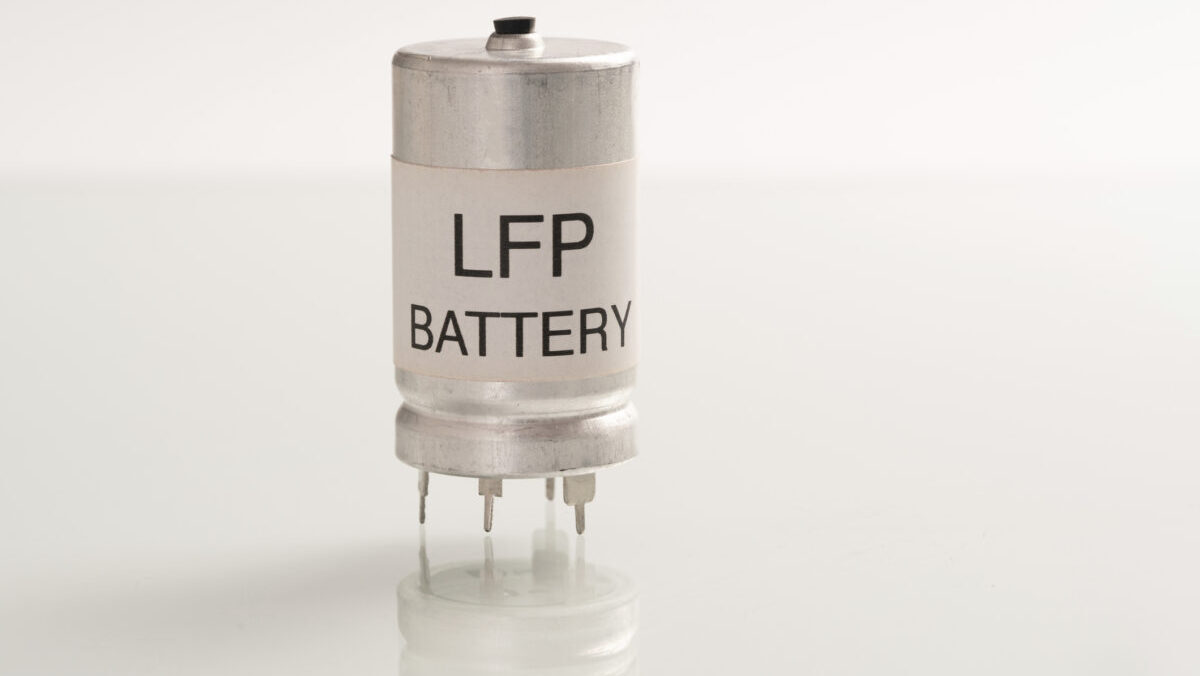EVs are using less nickel and cobalt as carmakers aim for budget prices, and that might actually be good for these Aussie miners

Pic: WLADIMIR BULGAR/SCIENCE PHOTO LIBRARY via Getty Images
- The rise of cheaper LFP battery chemistries in electric vehicles has often been seen as a challenge to Australia’s resource sector with nickel and cobalt on the outer
- But as LFP demand rises outside China, Western suppliers of commodities like phosphate, manganese and fluorspar could benefit
- Which Aussie manganese and phosphate players could get a shot in the arm from LFP batteries
When the growth engine for demand for lithium ion batteries shifted from consumer electronics to electric vehicles, Australia became pretty bloody excited.
Not only did we have the geology to dominate China’s biggest industrial enterprise in steel through our world class supplies of iron ore and premium hard coking coal, now we had the highest quality reserves in the world of the metals that would help it and the world replace diesel and petrol cars with EVs for decades to come.
That enthusiasm has been tempered somewhat by a couple of developments.
Demand for lithium and nickel continues to grow. But so has supply — at a much faster pace — which has seen lithium prices fall 90% in the past year and nickel metal returns slide by half, prompting mine closures and production slowdowns among higher cost Australian operators.
On top of that is the fear that the nickel-cobalt-manganese cathode which used to dominate the EV battery market will be superceded.
While sodium ion batteries — which would eschew lithium altogether — appear some way off and are largely conceptual when it comes to their use in passenger EVs, a push by Chinese car and battery makers to lower cell costs has seen a chemistry called LFP (lithium-iron-phosphate) grab increasing market share.
From 45% last year, Benchmark Mineral Intelligence thinks LFP chemistries will take almost half the battery cell demand in 2024 as Chinese EV producers seek to transition from luxury to consumer buyers.
There is a growing push outside China to develop LFP capacity as well. From a low base, Benchmark’s product director of battery chemicals Maximilian Court told delegates at last weeks’ Benchmark World Tour, US production was expected to lift 280x, with production in Europe to lift 120x in the coming years, with more additional LFP supply expected out of Korea.
Australia’s geological attributes appeared almost perfectly suited to NCM batteries, especially with nickel rich chemistries on the rise, another gift from God to ‘The Lucky Country’.
While it still needs lots of lithium, where Australia is the number 1 supplier by a country mile, the rise of LFP posed a major challenge to that myth, even before Indonesia’s flooding of the nickel market sent Aussie mines into mothballs.
But Court said there remained opportunities for Australia. While out iron ore industry doesn’t supply products suited to LFP chemistries (and is seeing more than enough demand right now from steelmakers to put any existential fears into the distant future) there are other sectors where Australian miners can grab a foothold in the other side of the battery market — from phosphate to manganese and even the little known mineral fluorspar.
“There’s still a lot of threads that can be pulled on a WA and Australian story that can feed into all these different stages of the battery supply chain,” he said.
High purity phosphate – the Aussie players
There are two major commercial scale phosphate operations in Australia, both in north Queensland. One is Incitec Pivot’s (ASX:IPL) 975,000tpa Phosphate Hill mine, which produces a merchant grade phosphoric acid which is a feedstock for fertilisers used in cropping agriculture.
But higher grade feedstocks — like the 34% P2O5 rock extracted at Centrex’s (ASX:CXM) Ardmore project — can be used to make high purity (80%+) phosphoric acid.
This kind is an ingredient in LFP batteries.
Centrex recently raised $8 million to upscale from its current production rate of 240,000tpa to 625,000tpa over the next 12 months. Around 500,000t will go to Antipodean fertiliser producers, with the balance likely sold into Asia.
But CEO Robert Mencel said demand from the EV sector is rising, fielding his first calls on supplying LFP batteries from Ardmore around 12 months ago.
“We’ve had inquiries from customers who make phosphoric acid for lithium iron phosphate batteries,” he said.
“It’s actually about this time last year that I got my first call from a battery manufacturer in China. He was seeking feedstock exactly for the purpose.
“We’ve been doing test work on high purity phosphoric acid with Prayon, who are one of the leaders in the world (in phosphate processing). We’ve sent products to Europe for test work and some of the initial feedback’s been good. The initial results have been good.
“The demand for batteries is only part of it because Australia currently imports approximately around 30-40,000 tonnes a year of high purity phosphoric acid.”
Batteries could see North American and European market double
Batteries are just one use for high purity phosphoric acid — premium cleaning products, animal feed, food additives and obviously fertiliser are among the key end markets.
But EVs may have a larger impact on pricing than other sources, with demand from LFP battery producers expected to soar.
CRU Group thinks purified acid supply in North America and Europe may need to double by 2045, depending on how the global structure of the EV supply chain crystallises.
Currently China boasts around 99% of LFP capacity, and in a world that retains that status quo, it will likely procure most of its supplies from local producers.
But Western carmakers are growing increasingly interested in LFP in a world where they know EV costs need to come down, lest Chinese auto firms like BYD corner the budget market. If America and Europe could fully localise their LFP production however, CRU says demand for high purity phosphoric acid would lift 60% and 90% respectively by 2045 and 80 and 130% respectively in a high LFP demand scenario.
Benchmark’s Court noted not all phosphates are suitable. The level of impurities in the rock is an important consideration.
“You can make lots of fertiliser products out of phosphate which have impurities and heavy metals involved, but those typically aren’t suitable for a battery because it can cause a reduction in performance and also safety concerns too,” he said.
“So what we need to see for that part of the ecosystem is roughly 2.5 million tonnes of projects coming to fruition to solve a deficit of about 700,000 tonnes by 2030.”
Mencel said many sources of phosphate were high in cadmium, a big stumbling block when it comes to refining to the purity required for battery product.
“Some of these other high grade phosphate rock operations, they might go 40 to 60 to 80ppm cadmium. And the problem with that is it requires more sophisticated purification processes, because you have to remove the metal within the phosphoric acid. So the other things that people look for are copper, zinc, lead.”
ESG considerations will be important as well. While China could export phosphoric acid and LFP batteries to international carmakers depending on policy settings, the thermal cracking process is energy intensive and polluting compared to the hydrometallurgical processes used in the West.
The battery manganese story
While manganese has long been a part of the NCM story, it is increasingly being used to dope LFP batteries to improve their energy density in a bid to bring their charge time closer to premium NCM models.
This will go some way to reducing ‘range anxiety’, referring to the concerns ICE drivers have that they will not be able to drive for long periods of time without stopping to recharge their batteries.
While manganese prices are at cyclical lows right now, Court said the growth of manganese use in LFP chemistries could shift the market or battery grade manganese into deficit by 2030.
“There are market sources out there that expect something like 100 gigawatt hours of LMFP capacity by 2025 so there’s strong uptake and lots of different companies making their own recipes around that kind of chemical balance,” Court said.
One of Australia’s few active manganese producers — Element25 (ASX:E25) — has already secured the support of Western auto giants Stellantis and General Motors to build a high purity manganese sulphate plant in the United States, supplied by material from its Butcherbird mine in the Pilbara.
“In the LMFP side of life there’s two basic raw materials that they need. One is the manganese sulphate which is broadly the same as the manganese sulfate they need for NMC cathode manufacturing,” MD Justin Brown told Stockhead.
“But the other one is manganese carbonate which goes into a different LMFP flowsheet. So in our case to produce carbonate we would basically convert our sulphate to carbonate and deliver into that supply chain.”
Brown said the improvement in the demand outlook for manganese — largely used in the steel industry — could be ‘potentially huge’.
“They basically go from in the latest generation of NMC 8-1-1 chemistries, which has around 10% manganese, the LMFP chemistries have about 70% manganese,” he said.
“If you use a 9-5-5 chemistry NMC you’re almost talking 15x uplift. So somewhere between that sort of seven and 15 times demand growth is what the prize is.
“They’re not the only chemistries either. You’ve got LMNO (lithium-manganese-nickel-oxide) as well, which a number of companies are working on, and you’ve got LMRs which is sort of a bag term for lithium manganese rich, which are not strictly LFPs, they’re other flavours of high manganese cathodes and you’ve seen Umicore out and announce that they’re bringing to market high manganese cathode materials next year.
“So I think on a number of fronts you’ve got this shift to manganese as one of the potentially dominant cathode materials and that’s because there’s a net reduction in cost per kilowatt hour. There’s an improvement in the availability because manganese is just fundamentally more abundant than nickel and cobalt.
“And then you’ve also got the power improvement over traditional LFP.”
Which ASX players are in this market?
So which ASX players have made moves to participate in this market?
On the manganese side some of the big producers are looking to access the high purity manganese sulphate market, notably South32 (ASX:S32), which thinks the Clark deposit at its Hermosa project in Arizona where it will first develop the $1.7 billion Taylor zinc-lead-silver mine could be used to go upstream.
It also owns major manganese operations in South Africa and at GEMCO — one of the world’s highest grade and cheapest manganese operations in the Northern Territory — but is less likely to go the battery manganese route at those mines, which are already established and have shorter lives ahead of them.
Jupiter Mines (ASX:JMS) owns around half of the Tshipi mine and has flagged the potential to have a HPMSM plant operating by 2027-2028 having produced the first 99.9% pure HPMSM in South Africa last year.
Firebird Metals (ASX:FRB), which owns the Oakover project in the Pilbara, has announced plans to study a Chinese based HPMSM plant utilising feed from its Aussie deposit.
Over in Czechia, Euro Manganese (ASX:EMN) is seeking to tap Europe’s only substantive manganese reserve out of tailings of a mine shut for almost 50 years in Chvaletice, around 90km east of Prague.
Having raised US$100 million in finance from Orion ahead of the development, EMN is planning to produce high purity manganese sulphate and manganese metal for lithium ion batteries from 2027 via a downstream plant in Becancour, Quebec.
According to a feasibility study in 2022, the project would produce 48,000tpa of manganese, including around 100,000t of HPMSM and 15,000t of metal, equivalent to around 20% of Europe’s high purity manganese demand.
When it comes to phosphate, RareX (ASX:REE) is another Aussie player which has touted the potential to supply product to the LFP market.
With a unique blend of marketable phosphate and rare earths oxides, the junior released a strategic project update in October last year showing it could supply 12,000t of rare earths oxides and 169,000t of ‘battery grade phosphate’ for 15 years from its Cummins Range project in WA’s Kimberley region.
That would see it play into the EV market both in the supply of magnet metals for motors and LFP battery cells, with its material potentially substantive enough to supply 2.5 million EVs a year.
REE also signed a MoU for offtake with Nitron for its phosphate to be used in fertilisers, with Nitron signing up to purchase 250,000t of 25% P2O5 DSO for the first stage of its offtake deal from 2025 and 250,000tpa of upgraded 32% P2O5 from 2028.
An updated resource last month showed Cummins Range holds some 524Mt at 0.31% TREO and 4.6% P2O5 for 1.6 million tonnes of contained TREO and 24 million tonnes of contained P2O5.
Minbos Resources (ASX:MNB), which owns the Cabinda project in Angola, has also reported receiving inbound inquiries from battery makers who view the grade and impurity profile as favourable for use in LFP cells.
There have been companies looking to go as far as producing LFP in Australia. Avenira (ASX:AEV), which owns the Wonarah phosphate and yellow phosphorous proposal near Tennant Creek in the NT, has proposed to produce cathode active material for LFP batteries at a plant in Darwin using technology developed by a Taiwanese company called Aleees.
“Our recent engagement with global car manufacturers has validated our selection of Aleees as our technology partner. It has also highlighted, very clearly, how important LFP is in the selection of batteries for the electric vehicle industry in the next few years,” AEV executive chairman Brett Clark said on announcing an extension to its time to make a stage US$2m payment to Aleees under its licence agreement in November.
“LFP chemistries are forecast to take an increasing share of the battery market for the electric car and light vehicle sector. Avenira aims to capture a meaningful share of the ex-China market for LFP.”
Lithium Australia (ASX:LIT) also announced an MoU with Canada’s First Phosphate to pursue “the potential development of a lithium iron phosphate (LFP) and lithium manganese iron phosphate (LMFP) cathode active material manufacturing plant in North America.”
Also playing a role in LFP batteries is fluorspar, which is used not in the cathode but in the electrolyte.
The price of acid grade fluorspar hit record highs in US dollar terms in 2023, with Tivan (ASX:TVN) announcing plans earlier this year to conduct a pre-feasibility study on the fluroite resource at its Speewah project after the Australian Government designated the commodity as a critical mineral in December.
At Stockhead we tell it like it is. While RareX was a Stockhead advertiser at the time of writing, it did not sponsor this article.

UNLOCK INSIGHTS
Discover the untold stories of emerging ASX stocks.
Daily news and expert analysis, it's free to subscribe.
By proceeding, you confirm you understand that we handle personal information in accordance with our Privacy Policy.








